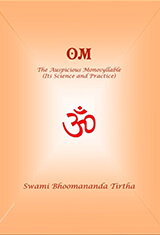Resources
description

Verses for Introspection
Shloka 33 ankolam nijabeeja
Ma Gurupriya
Shloka 33 ankolam nijabeeja
Ma Gurupriya
What is Devotion?
अंकोलं निजबीजसन्ततिरयस्कान्तोपलं सूचिका
साध्वी नैजविभुं लता क्षितिरुहं सिन्धुः सरिद्वल्लभम् ।
प्राप्नोतीह यथा तथा पशुपतेः पादारविन्दद्वयं
चेतोवृत्तिरुपेत्य तिष्ठति सदा सा भक्तिरित्युच्यते ।।
– शिवानन्दलहरी ६१
aṅkolaṁ nija-bīja-santatir-ayaskāntopalaṃ sūcikā
sādhvī naija-vibhuṃ latā kṣitiruhaṃ sindhuḥ sarid-vallabham ।
prāpnotīha yathā tathā paśupateḥ pādāravinda-dvayaṃ
ceto-vṛttir-upetya tiṣṭhati sadā sā bhaktir-ityucyate ।।
– Śivānandalaharī 61
Translation:
As the ankola seed finds its way to the mother-tree from which it has fallen, as the iron needle irresistibly moves to the magnet placed nearby, as the chaste woman looks solely to her husband for delight, as the growing creeper rests fully upon the tree for its support, as the flowing river rushes to the ocean to merge in it – in the same manner when the mind seeks out ardently the two lotus-feet of Pashupati (Śiva), and remains fixed on them always, then that indeed is called devotion.
Points for Introspection:
Whenever we think or talk of devotion, the mind becomes soft and delighted; eyes become filled with tears. We feel God to be very near to our heart. We feel a sense of refuge. All other thoughts disappear from the mind making it supremely peaceful.
What is this Devotion in essence? What is supreme Devotion? Devotion is that state of the mind when one’s thought processes merge entirely with the object of devotion in intense love and fondness. The mind at that time becomes oblivious of any other thought or object and one-pointedly surrenders itself to the beloved.
This śloka tells us about that supreme devotion through many examples.
There is a tree called “Aṅkola”. The seeds of the fruits, fallen here and there from this tree, germinate only when they get back to the mother tree. So, in order to be able to sprout and grow, these seeds have to reach back to the mother-tree.
When iron-needles are kept near a magnet, without looking at anything else, these iron-needles go straight to the magnet and get fixed there. A chaste woman always thinks about her husband alone for her delight and support. Her mind, in the midst of all kinds of chores, remains fixed only on her husband.
A creeper always holds on to the supporting tree for its growth. Even if we loosen the creeper from the tree on which it has grown, soon we find that the creeper has wound itself around the tree again. This shows the one-pointedness of the yearning of the creeper.
Similarly all rivers rush towards the ocean, in order to get merged into it, the real source of the rivers. There may be obstacles on the way, like mountains, valleys, forests, cities and villages. The river with the one-pointed thought about its union with the ocean, overcomes all obstacles and meets the ocean.
The one-pointedness in all these examples illustrates what devotion is. In devotion, the mind of the devotee finds complete restfulness at the lotus feet of the Lord, after seeking them ardently, to the exclusion of anything else. Such intense one-pointed seeking is called devotion.
This śloka has a beautiful metre. When we chant this śloka again and again, and we identify ourselves with the one-pointed yearning of the aṅkola seed, the iron-needles, the chaste woman, the creeper and the river, we fill ourselves with supreme devotion at the Lord’s feet. We find our mind supremely restful at the holy feet of the Lord, having attained the union which we seek ever and ever.
Word Meaning:
अंकोलम् (aṅkolaṁ) = the ankola tree; निजबीजसन्ततिः (nija-bīja-santatiḥ) = its own seed for proliferation; अयस्कान्तोपलम् (ayaskāntopalam) = loadstone, magnet; सूचिका (sūcikā) = needle; साध्वी (sādhvī) = chaste woman; नैजविभुम् (naijavibhum) = one’s own lord/husband; लता (latā) = creeper; क्षितिरुहम् (kṣitiruham) = tree; सिन्धुः (sindhuḥ) = river; सरिद्वल्लभम् (sarid-vallabham) = ocean – the beloved; प्राप्नोति (prāpnoti) = attains; इह (iha) = here; यथा तथा (yathā tathā) = in any way; पशुपतेः (paśupateḥ) = of Lord Pashupati, Śiva; पादारविन्दद्वयम् (pādāravinda-dvayam) = two lotus feet; चेतोवृत्तिः (cetovṛttiḥ) = mind’s functions; उपेत्य (upetya) = having approached; तिष्ठति (tiṣṭhati) = stays; सदा (sadā) = always; सा (sā) = that; भक्तिः (bhaktiḥ) = bhakti, devotion; इति (iti) = thus, in this manner; उच्यते (ucyate) = called;
अन्वयः
यथा अंकोलम् निजबीजसन्ततिः, अयस्कान्तोपलं सूचिका, साध्वी नैजविभुं, लता क्षितिरुहं, सिन्धुः सरिद्वल्लभम् प्राप्नोति, तथा इह पशुपतेः पादारविन्दद्वयं उपेत्य, चेतोवृत्तिः सदा तिष्ठति; सा भक्तिः इति उच्यते ।
yathā aṅkolaṁ nijabīja-santatiḥ, ayaskāntopalaṃ sūcikā, sādhvī naija-vibhuṃ, latā kṣitiruhaṃ, sindhuḥ sarid-vallabhaṃ prāpnoti, tathā iha paśupateḥ pādāravinda-dvayaṁ upetya, ceto-vṛttiḥ sadā tiṣṭhati; sā bhaktiḥ iti ucyate.
Verses for Introspection
Shloka 33 ankolam nijabeeja
Ma Gurupriya
You Might Be Interested In
Shloka 39 shantaa mahaa...
Shloka 39 shantaa mahaanto
Ma Gurupriya
Shloka 62 aashaa naama ...
Shloka 62 aashaa naama nadi
Ma Gurupriya
Shloka 80 bhayam dvitee...
Shloka 80 bhayam dviteeyaabhiniveshatah
Ma Gurupriya










